If you’ve ever had an online store or shopped online, you probably know how hard it can be when many people leave their shopping carts. Even if you try to make your website’s user interface as good as possible and complete the checkout process quickly, customers still leave their carts at an alarming rate.
In fact, industry research indicates that average cart abandonment rates currently stand at a staggering 69.57%.
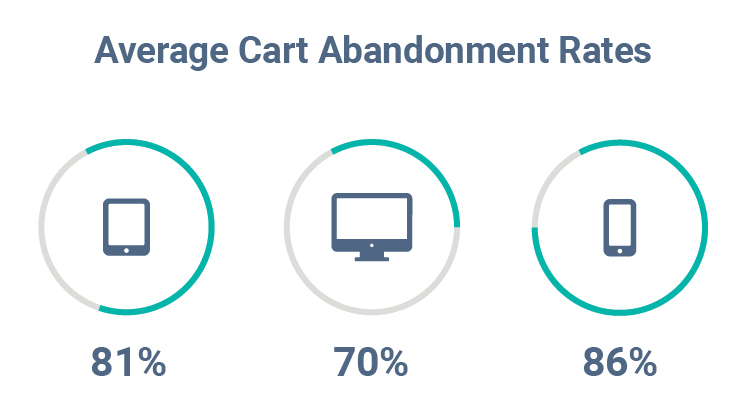
The implications of this trend are profound: lost revenue, decreased customer engagement, and a negative impact on your brand reputation. Furthermore, with so many businesses vying for customer attention and loyalty, addressing cart abandonment is crucial to maintaining a competitive edge.
Did you know that the fashion industry has the highest cart abandonment rate?
To make things work out and address the cart abandonment challenge easily, we bring you 10 practical strategies that empower your e-commerce business to decrease the shopping cart abandonment rate and accelerate your store’s success in the e-commerce industry.
What is Cart Abandonment?

Imagine walking into a grocery store, filling up your shopping cart with all your favorite snacks and drinks, only to be abandoned at the midway and back home empty-handed. Sounds absurd, doesn’t it? But exactly what happens in the world of e-commerce, where consumers add items to their online shopping cart but leave the website in the middle of browsing without completing the purchase- a phenomenon known as cart abandonment.
Cart abandonment is the major hurdle for online retailers, resulting in lost sales and revenue.
Content Square reports the highest cart abandonment rates among the 25-44 age group. That’s a lot of abandoned shopping carts!
The history of cart abandonment can be traced back to the early days of e-commerce when online shopping was a new and exciting concept. As online shopping became more popular, retailers noticed a trend of customers abandoning their carts before completing the purchase. Over time, shopping cart abandonment has become a familiar and persistent challenge for e-commerce businesses.
Shopping Cart Abandonment Statistics
Shopping cart abandonment is a primary concern for online retailers, and understanding its impact is essential to developing effective strategies to tackle it.
Let’s dig deeper into shopping cart abandonment statistics:
- Every year, online retailers lose a staggering $18 billion due to cart abandonment.
- Shopping cart abandon rates are higher among customers who shop using mobile devices.
- High costs during checkout become the main reason 40% of customers abandon their shopping carts.
- The fashion industry’s average shopping cart abandonment rate in 2022 was 84.56, the highest rate among different industries (Sales Cycle, 2022).
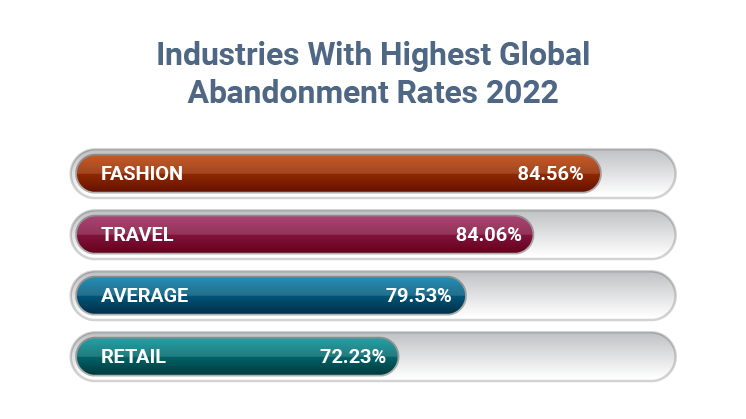
- According to the research, social media drives the highest cart abandonment rate, 91%.
- The estimated range for the average abandoned cart recovery rate in e-commerce is between 2.3% and 5.4%.
- 26% of customers who abandon their carts ultimately purchase the same product from competitors. (Royal Mall, 2020)
- Mainly, cart abandonment activity occurred between 6 pm and 9 pm.
These statistics highlight how cart abandonment is a costly problem for e-commerce businesses. You must inline your sales strategies to avoid facing this root cause of lost revenue in your e-commerce business.
Reasons: Why did the Abandonment Rate Increase
Reaching a 0% cart abandonment rate is next to impossible for any e-commerce business, but understanding the underlying reasons is essential to improving the customer purchasing journey. Knowing the reason can cause any business to lose hundreds of bucks and potentially loyal customers. So, to minimize all the possibilities, understand the main reasons behind cart abandonment.
– Mandatory Sign-Up
What will customers feel when they are lined up in the shopping mall to get their favorite pair of shoes and the store representative insists on signing up for a membership? Otherwise, they can’t complete the checking procedure. Try to visualize the situation that makes them anxious and compels them to leave the store and find somewhere else where membership is not required. You may find it a far-fetched reality, but it’s not too far from what happens when you shop from an e-commerce store and encounter forced account creation.
Baymard Institute’s studies indicate that 24% of shoppers abandon the cart if they have to create a new account.
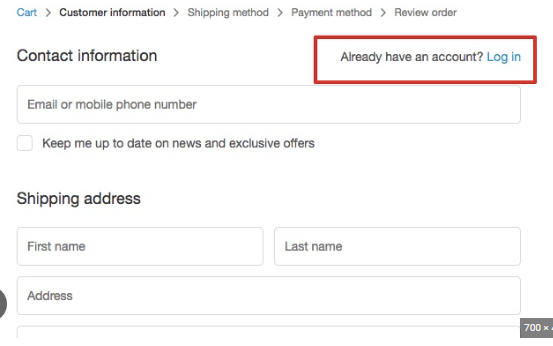
Therefore, online store owners must realize how mandating user registration at checkout can affect their shopping cart abandonment rate.
Instead, they should learn from Walmart, which introduces guest checkout that allows the simple purchasing procedure to perform any complex process.
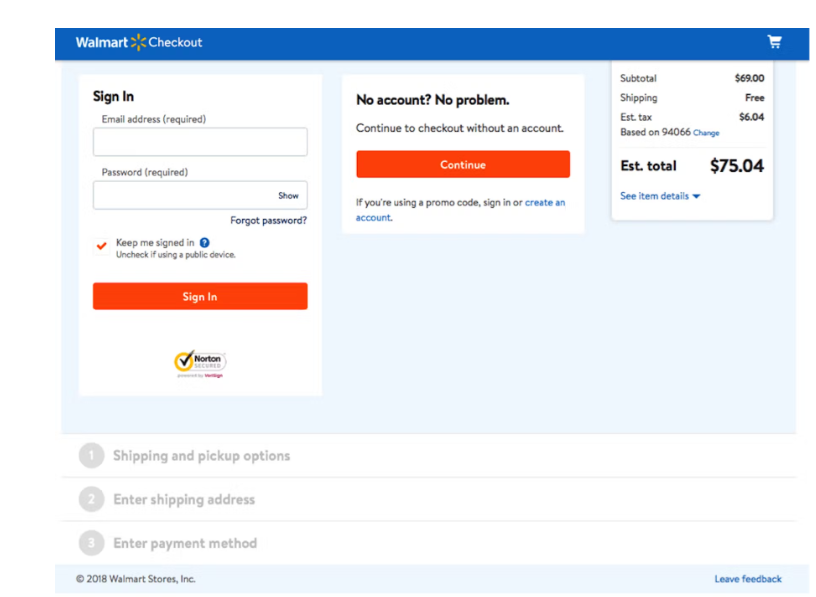
– Complex or Multi-Step Checkout
Poor or complex checkout processes can wreak havoc on an e-commerce business’s success. Just look at the number: 73% of shoppers abandon carts because of the complex checkout process.
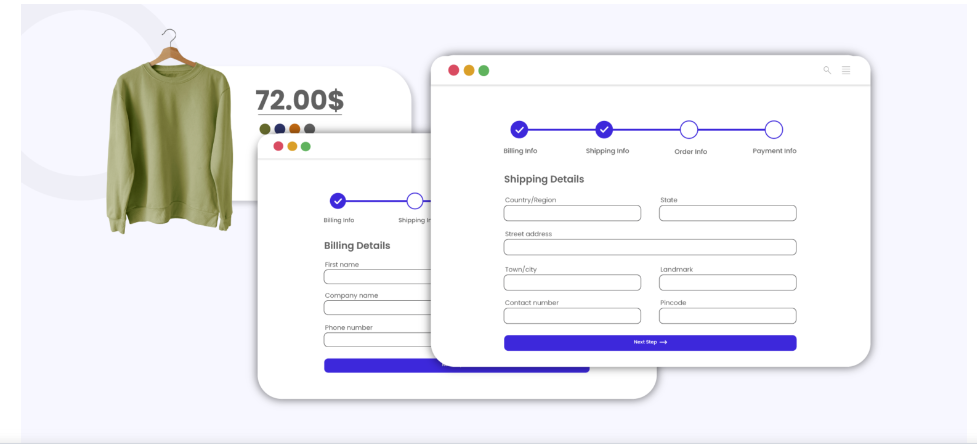
Just consider a moment when a customer feels frustrated by entering unnecessary details like date of birth and filling out 3 to 4 pages of the checkout form. As a result, they abandon the cart and forego purchases that have been completed in simple steps. That’s why simplifying a checkout process can improve the business success rate and improve customer satisfaction.
– Security Breaches
Security is the foundation of success, but what will happen to your business if your e-commerce website has security loopholes? Since the cybercrime rate is so high, people are afraid to shop online because chances are high that their personal information may be misused.
One study indicates that 35% of potential customers abandon the cart if they don’t find a security badge on the website.
Payment security is also a concern when it comes to cart abandonment.
1 out of 3 shoppers is anxious to purchase a product through online websites because of security concerns.
Therefore, e-commerce businesses must consider the solution to prioritize payment security to give customers a better experience.
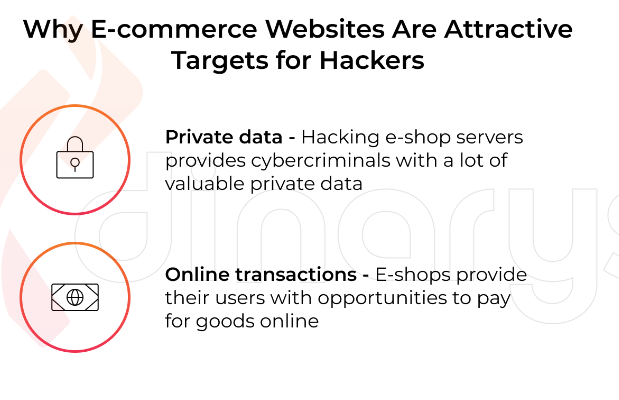
– Slow Website Speed
In a fast-paced world where everything can be done in a blink of an eye, having a slow website can cause a long pause in boosting your sales. Customers may feel frustrated if a website takes over 2 seconds to load.
Also, 53% of shoppers would abandon the purchase if the website takes more than three seconds to load.
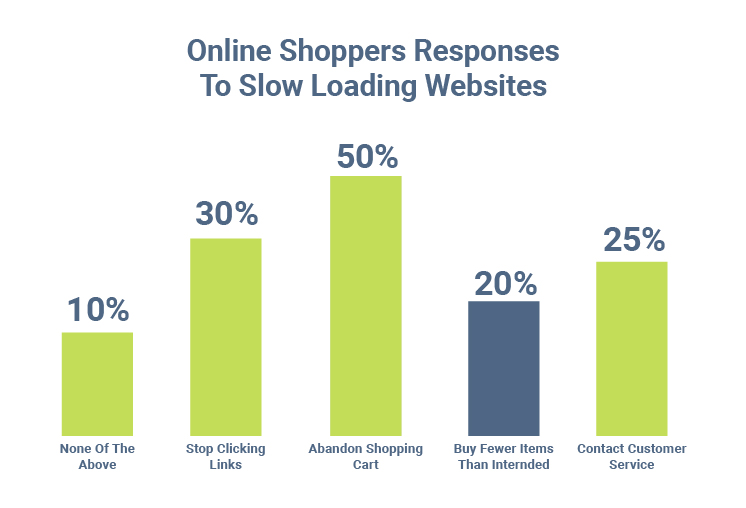
You might find it interesting that a few years back, Amazon found out that its website gets to load every extra second, costing the company an estimated $1.6 billion in sales every year. However, a big business was strong enough to tolerate such penalties.
However, even with the recognized importance of WordPress website speed optimization, only 21% of small businesses took steps to improve their website speed.
– No Price Conversion
Pricing is the first thing every customer wants to know about the product. Imagine a customer finds the product on your website he’s been searching for a long time, but your website fails to convert the prices into the customer’s desired currency. Now, here, the drawback jumps in between. They ditched the purchase at the last moment because they didn’t get the price in their local currency and kept the product in the abandoned cart.
92% of customers like to shop in their currency, while 33% will abandon the cart if pricing only displays in dollars
10 Ways to Reduce Shopping Cart Abandonment Rate
Shopping cart abandonment is a persistent challenge for online businesses when out of 10 consumers who add a product to their cart, only 3 finalize the order.
The above trend can lead to significant business losses, with some reports estimating that abandoned carts cost retailers over $4 trillion in lost revenue per year. However, there are strategies that implementation can help the business in lowering the cart abandonment rate.
Look at these 10 practical solutions that improve your e-commerce sales:
1. Simplify the Checkout Process
A customer excited to purchase some items is asked to complete a lengthy procedure, from registering to providing personal details. You are reluctant because you can’t trust someone with your details online. Simply, in the next step, you would dump that business.
This is the typical scenario online shoppers experience, becoming the significant reason for the increasing shopping cart abandonment rate.
In terms of numbers, one in every five abandons their purchase due to complicated and time-consuming checkout.
Are you ready to make your e-commerce website process easy with a plugin like instant checkout for WooCommerce? Try this and get impeccable benefits, including loyal customers and a better conversion rate.
Did you know a simple, streamlined checkout process can significantly impact online sales? In fact, retailers who use simple checkouts have reported a 20%-60% reduction in cart abandonment.
2. Creating a Mobile App
One effective way to decrease the cart abandonment rate is creating a mobile app for an e-commerce website. It lets you offer personalized and seamless experiences to your customers with advanced features like push notifications, customized recommendations, wishlists, location-based service, and many more.
There is no doubt about the success of this strategy because 62% of smartphone owners use their devices to make purchases.
Mobile apps are designed with user experience in mind, providing a seamless and user-friendly interface for customers. This can make it easier and more convenient for them to complete their purchase, reducing the likelihood of card abandonment.
3. Follow Up with Abandoned Carts
Leaving the cart abandoned is the most common practice that almost 70% of shoppers perform. However, there is a way to recover some potential customers by sending follow-up emails or notifications.
One effective way is to send follow-up emails offering reminders or incentives to consumers who have abandoned their carts. By offering discounts, free shipping, or spinning a wheel to win points, you can encourage them to complete their purchase. This can be easily implemented using plugins, such as email templates, customizer, and designer, which allows you to send transactional emails to customers who left items in their carts.
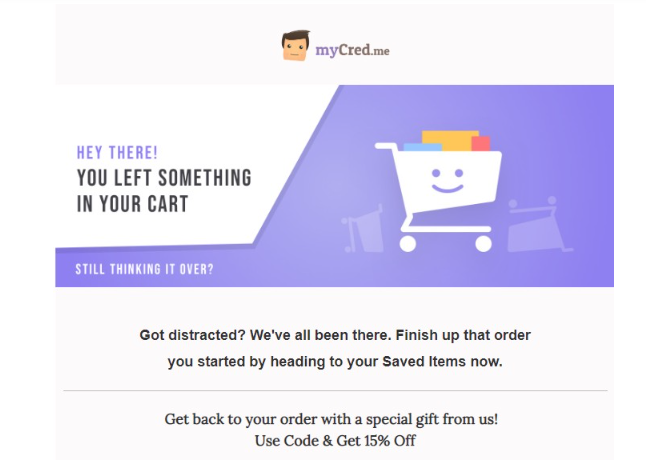
According to Sales Cycle, 46.1% of abandoned cart recovery emails are opened, with a 13.3% click-through rate and a 35.3% conversion rate.
4. Display Shipping Cost Upfront
Unexpected shipping costs at the end of the checkout process are another key contributor to the increasing cart abandonment rate.
According to a study, 60% of customers abandoned their carts due to unexpected shipping costs.
One of the best solutions is to display shipping costs upfront, as early in the checkout process as possible. This way, customers can see the total cost of their order before they invest time in filling out other details. Also, offering free shipping can be a decisive move to increase sales.
Many E-commerce platforms, like WooCommerce and Shopify, offer plugins that make it easy for businesses to display shipping costs in the initial stage. For example, when you install instant checkout on your website, you give your customers the liberty to know each product’s total through the pop-up as soon as they add it to the cart.
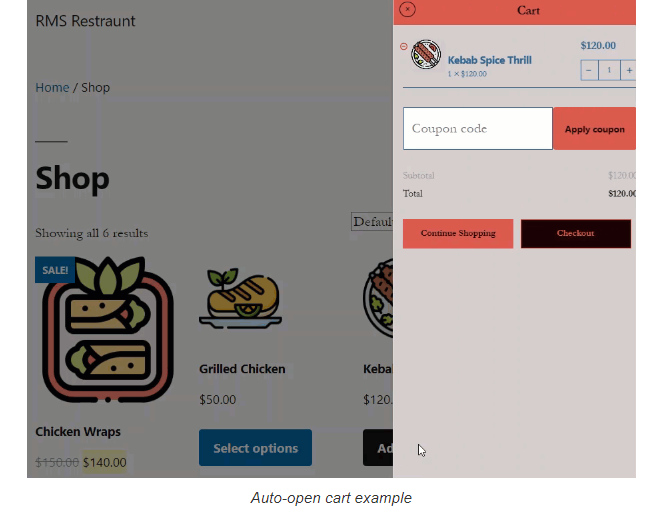
5. Enable Multiple Payment Options
In today’s ever-evolving e-commerce landscape, offering multiple payment options has become a prerequisite for online retailers. By providing customers with a range of payment options, businesses can cater to a broader customer base, increasing revenue and less shopping cart abandonment rates. Accepting credit/debit cards, e-wallets, and online payments are the popular payment options that can be integrated into any e-commerce business checkout process.
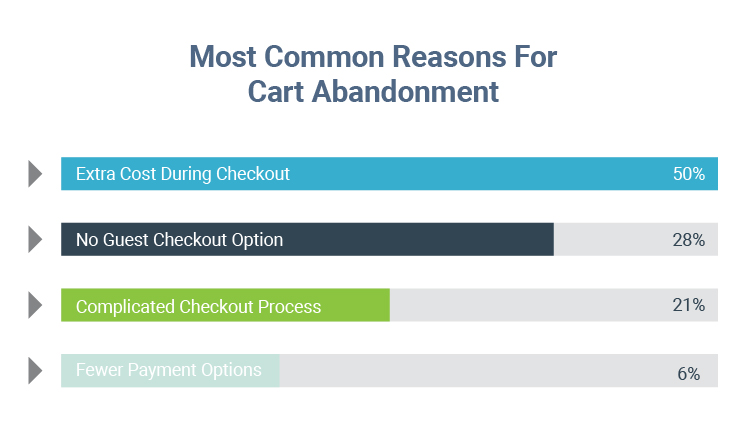
Integrating plugins like WPEasyPay smooths your checkout process and reduces cart abandonment rates. You can expand customer satisfaction and build brand loyalty by offering multiple payment options, ultimately driving revenue growth.
6. Provide Customer Support
As an e-commerce business owner, you know that shopping cart abandonment is the worst thing for any business. The most powerful thing can completely change your revenue generation game. But instead of fearing this aspect, one should focus on executing a customer support strategy.
Let’s say a customer has experienced an issue with a product they put in the cart to buy but is still determining the sizing or weight. For that reason, I want to discuss the product in detail with a business representative, but the business doesn’t have any chat support to answer the query. Here, the games change as customers abandon the cart because no option is available, letting the customer come in contact with a business and get their queries answered.
Providing customer support with different channels can change your business fate and help you get the leading position in your respective industry. Like Zappos, the online retailer is recognized for its exceptional consumer support through multiple channels and even for providing free returns. Only focusing on this approach helped them establish their top position in the ranking chart and achieve immense success.
7. Allow Bulk Purchasing
Customers enjoy discounts ranging from 20% to 83% when purchasing bulk.
A business can simplify purchasing by allowing customers to buy multiple products in a single order, saving the customer time, effort, and money. Consider a scenario where a potential buyer is shopping for groceries and wants to stock essentials like fruits, canned food, or rice for special occasions. However, online grocery stores limit the number of purchases in a single order, making the process time-consuming and frustrating, ultimately resulting in an increasing cart abandonment rate.
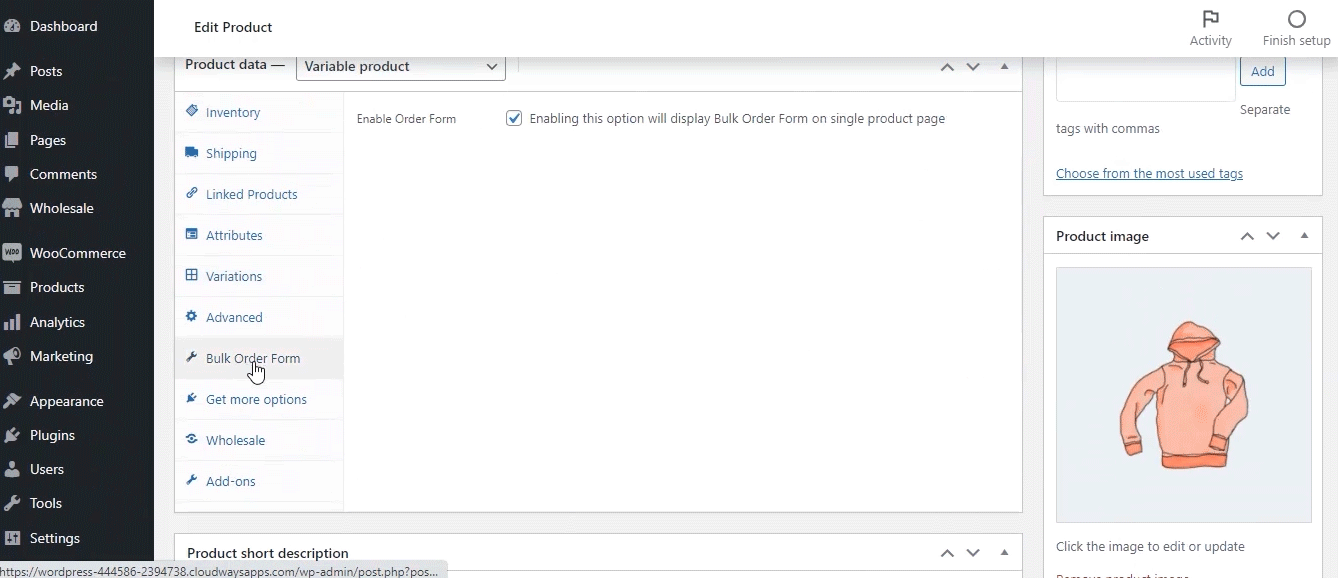
So, allowing your customers to purchase bulk on your e-commerce store is necessary to provide an easy and convenient way to purchase all the items in one go. Implementation of this technique can be beneficial for both customers and businesses.
8. Offer Promotional Deals & Flash Sales
When customers are presented with limited-time offers and special deals, they are more likely to complete their purchase and avoid abandoning a cart.

When you offer flash sales that last for a short period, create a situation of urgency among customers, encouraging them to take action before the end of the sale. This can help lessen the shopping cart abandonment rate because customers will likely place an order when a sale occurs.
Similarly, promotional deals like free shipping or a percentage off the total price can encourage customers to complete their transactions and reduce the chances of cart abandonment. According to research, free shipping is the primary motivator for more than half (50%+) of online shoppers when ordering online.
9. Provide a Clear Return & Refund Policy
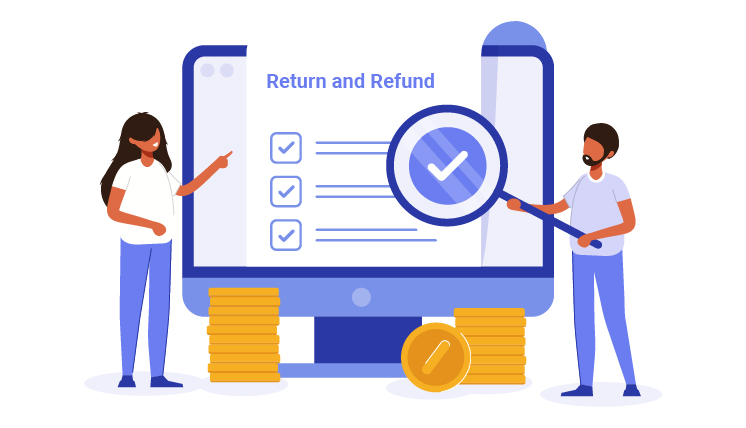
92% of customers purchase if the return is easy, whereas 58% want a hassle-free refund policy.
Offering a transparent return and refund policy is critical to building trust and confidence with your customers. A well-communicated return policy can help brands in building trust and confidence in their customers, assuring them that they can shop without the fear of losing money if the product doesn’t turn out what they want.
10. Add Strong Call To Action On Checkout Pages
A call to action, or CTA, is a prompt that encourages potential customers to take specific actions. For Example, CTA can urge customers to purchase and get 30% off on the following order. With the help of convincing language and eye-catching checkout page design components, businesses may generate a sense of urgency and encourage visitors to take action before they leave the website.
Did you know that implementing calls to action on landing pages has been shown to improve the conversion rate for marketers by 14% to 18%?
Wrap-Up
Since the cart abandonment rate is high in the e-commerce industry, the business misses out on significant revenue and frustrates potential customers. In the evolving e-commerce trends, where competition is fierce and user experience is paramount, minimizing the shopping cart abandonment rate has become a vital objective for businesses seeking to maintain a competitive edge. However, by implementing these ten proven techniques discussed in this blog, online businesses can easily overcome this challenge and keep customers actively engaged throughout the shopping journey.
FAQ’s
Q1. Why reduce checkout abandonment?
Reducing checkout abandonment is necessary to maximize revenue and optimize conversion rates while improving customer satisfaction and loyalty by ensuring a smooth shopping experience.
Q2. What is a good shopping cart abandonment rate?
The average cart abandonment rate is 70%. Still, a 20-30% low rate is ideal and achievable through effective strategies like improving website usability, simplifying the checkout process, and offering incentives to complete the purchase.
Q3. Why do people add to the cart but not checkout?
People may add items to their cart for shopping but not complete the checkout process due to various reasons, such as unexpected fees, a cumbersome checkout process, security concerns, and comparison shopping. Moreover, technical issues, distractions, or changes of mind can also contribute to cart abandonment.